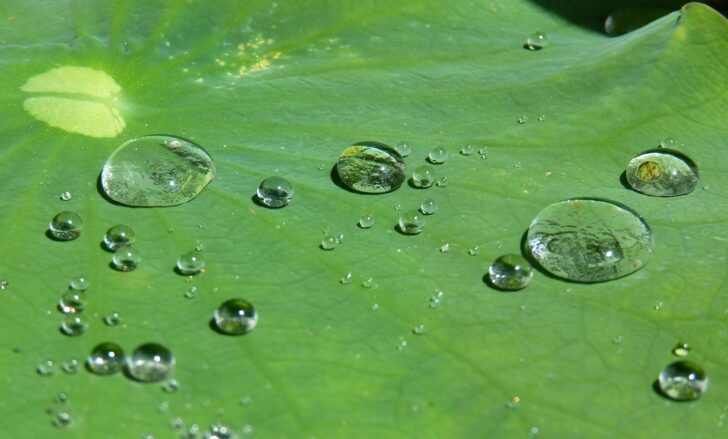Laser lotus effects

Fast and significantly more versatile than coatings: Fusion Bionic founded.
Nano- and microstructures can now be incorporated into surfaces by laser in no time at all. The technology is developed and marketed by the young Dresden-based company Fusion Bionic - a spin-off from the Fraunhofer Institute for Material and Beam Technology IWS. There are no limits to the imagination when it comes to laser structuring. Its advantage: it is fast and significantly more versatile than coatings.
Product surfaces can be enhanced by many different effects. With the lotus effect, for example, a microstructure ensures that dirt does not adhere but is simply washed off the next time it rains. The fine ripples of shark skin, on the other hand, improve the flow on the outside of airplanes and ships, which saves fuel. Until now, many such nature-inspired effects have been created by coating the surface or sticking films with microstructures imprinted on them. But coatings and foils can wear out, so the desired effect diminishes over time. In recent years, researchers at the Fraunhofer IWS and the Technical University of Dresden have brought an alternative method to market maturity that can be used to permanently provide surfaces with nano- and microstructures: direct laser interference patterning (DLIP). In this process, the nano- or microstructure is inscribed directly into the surface by laser to create biomimetic effects. Remarkable is the high speed of the process, which can currently process an area of up to one square meter per minute. The new technology is so promising that this year the company Fusion Bionic was spun off from the Fraunhofer IWS. Fusion Bionic develops and sells DLIP system solutions for biomimetic surface finishing, but also performs surface functionalization itself on behalf of customers.
Fast enough for large surfaces
"Compared to coating or gluing, lasers were long considered much too slow to finish large surfaces," says Fusion Bionic CEO Dr. Tim Kunze, who founded the company with three partners. "With the DLIP process, however, we have taken the step toward processing large surfaces quickly." Classically, one thinks of a laser beam as a single fine beam. If you wanted to use it to work a pattern into a surface like a needle, you would lose far too much time. The DLIP process works differently. First, a laser beam is split into several beams. To introduce a pattern into the surface, the many laser beams are superimposed in a controlled manner so that a so-called interference pattern is created. This pattern can be distributed over a larger area, which makes large-area and fast processing possible.
The principle of interference is quickly explained: light propagates in waves. If two light beams are superimposed, their wave troughs and wave crests can cancel each other out or amplify each other. Where light hits the surface, the laser energy removes or alters material. The dark areas remain untouched. "We can use it to create almost any structure imaginable," says Tim Kunze. "Lotus effect, shark skin, moth eye and much more."
While he was still at the Fraunhofer IWS, his team worked closely with Prof. Andrés Lasagni of the Technical University of Dresden to develop a microstructure with Airbus that prevents ice from accumulating on the wings during flight. In conventional jets, this is prevented by directing warm exhaust air from the engines into the wings. However, this causes the engines to lose energy. The project found that the energy requirements of an ice protection system are reduced by 80 percent if the wing also has a DLIP microstructure. "This would also be a solution for future electrically powered aircraft in particular, because no waste heat is available from the engines in these," says Tim Kunze. In other projects, implants such as hip joint prostheses and dental implants were processed so that their surfaces are particularly biocompatible or have an antibacterial effect.
Funding by Fraunhofer AHEAD program
The impetus for DLIP development came a good ten years ago from laser expert Prof. Andrés Fabián Lasagni, when he moved from Saarbrücken University to the Fraunhofer IWS and focused on the technology. DLIP was a rather basic academic topic at the time. However, it was clear to Lasagni, who now holds the professorship for laser structuring of large surfaces at TU Dresden, that there was great potential in it. He built a powerful team at the Fraunhofer IWS, which continued to grow under his successor Tim Kunze starting in 2017. Building on Lasagni's groundbreaking preliminary work, the two developed industrial-grade DLIP optics together that have since been installed at numerous pilot customers worldwide. From 2020, it became clear that the commercialization of DLIP technology needed to be taken to a new level. "Our solutions offer a completely new degree of freedom in surface design at an unprecedented speed, enabling novel products and processes," explains Tim Kunze.
Fusion Bionic has been established through funding from the AHEAD program, through which the Fraunhofer-Gesellschaft enables spin-offs. "There is a great need for the functionalization of surfaces," sums up Lasagni. "Every industry has its own challenges there, whether it's the adhesion of ice cream to container walls or reducing friction. In that respect, we won't run out of work anytime soon."
To accelerate the development of innovative surfaces, Fusion Bionic is working on a prediction platform based on artificial intelligence with the support of its investor Avantgarde Labs Ventures. This will be used to realize advanced laser functionalities. In parallel, an "AI Test Bench" is being built at Fraunhofer IWS, a multi-sensor test bench for laser processing where Artificial Intelligence can be used to quickly predict and generate the optimal surface structure for any problem.
The founding members of Fusion Bionic include Dr. Sabri Alamri, Laura Kunze, Dr. Tim Kunze and Benjamin Krupop.
Source: chemie.de - Lotuseffekte lasern
Image source: pixabay